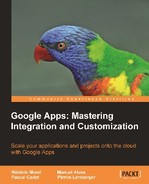There are several strategies for creating Google Apps user accounts.
This is the easiest and most straightforward way to create a new account using the administration console (as shown in the following screenshot):

Creating a user directly in the Google Apps console
Creating new users comes down to entering their last names, first names, usernames, and passwords. Later on, this new user can be added to one or more groups (see the section below devoted to group creation).

Defining other destinations
An administrator can define a specific routing for each user.
A simple way to simultaneously define a list of users is to upload a CSV file from the console. This file should have the structure shown in the following table:
|
A |
B |
C |
D |
|---|---|---|---|
|
username |
first name |
last name |
password |
|
Emc2 |
Albert |
Einstein |
Dgf7çgfh |
|
iPad |
Steve |
Jobs |
Vlc9fv8é |
|
Requiem |
Wolfgang Amadeus |
Mozart |
Pgoa77r0 |
The structure of the CSV file for a list of users
Before loading the file, the system will ask the administrator to choose between creating new users or modifying existing ones. The system will send a notification mail once the process is complete.
Beyond 500 users, it is better to split the list into smaller pieces. There are many small companies that offer services to support these and related tasks. The Google Apps Marketplace (see Chapter 6, Extending the Platform) is a good place to look for this kind of service, especially under "Small Business Implementation".
Groups are generally created to define mailing lists. Sending a message to each member of the group is done by sending a message using the address of the group instead.
A group can also be used to share documents with Google Docs, agendas from Google Calendar, a site from Google Sites, video, or to manage access to these resources.
The only information required to define a group is a name and an email address. The other attributes are a short description of the group and permissions. The latter determine which categories of users can send messages to this group (and not the other way around); we'll come back to this shortly.
An administrator can create a group directly from the console and add members to it, which can be either users or other groups (as shown in the following screenshot):

Adding a member to a group in the Google Apps console. The status of the new member of the group should be chosen: owner or member.
A new member can be added as an owner of the group or just as a regular member. This status will later determine the rights of this member regarding this group.

There are three kinds of access levels and one custom mode
There are three kinds of access levels and one custom mode:
- The team level. Any user from the domain my-domain.com can send messages to the group and see who is a member.
- The announcement level. Only group owners can send messages to the group and see who is in the group.
- The restricted level. Only group members can send messages to the group and see who is in the group.
- The custom level. The administrator defines which categories of users can send messages to the group and see who is in the group.

In the custom mode, the authorizations can be defined in detail
For specific purposes, there are other migration tools. Now we'll look at three of them. More details can be found in the section devoted to account creation on the Google Apps help site.
This API is only available for the Premier and Education versions. It is intended for developers who have to design custom migration tools. Using these APIs, the Google accounts can be automatically updated from an existing directory. A vast array of provisioning solutions from Google's partners is available on the Google Apps Marketplace.
This is a free tool, which allows provisioning user accounts from an LDAP directory such as Microsoft Active Directory or Lotus Domino. The tool actually synchronizes the data in the Google Apps accounts, shared contacts, and groups with information in an LDAP directory. The administrator has to define rules for this. More precisely, Google Apps Directory Sync ensures a one-way synchronization from the directory to the Google Apps accounts; the LDAP directory is left as is.
This is a free web tool, which allows quick creation and update of Google Apps user accounts (20 users per second, on average). The information source for the definition of the user accounts can be a CSV file, an LDAP directory, or a relational database.
Furthermore, the tool offers the possibility for users to create their Google accounts themselves by simply asking them to log in using an existing mechanism.
Administrators of a Google Apps domain can decide to let the users create and manage their own groups:

Activation in the console of user-managed groups.
This authorization can be granted at the level of a Google Apps domain only and not to specific individuals. It can be revoked at any time.
The advantages of such flexibility are numerous for end users. They will be able, for instance, to create their mailing lists or groups, which will be authorized to view private content. Groups that are reachable from outside the Google Apps domain can be created as well. This last option will prove particularly useful when setting up customer service or a help desk.
